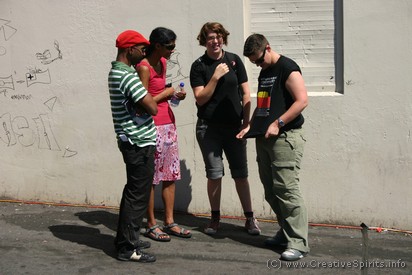Language
Too little Aboriginal bilingual education
English-only schools do not account for Aboriginal language speakers. Bilingual education is "most effective" yet often at the mercy of government policies.

Wishing you knew more about Aboriginal culture? Search no more.
Get key foundational knowledge about Aboriginal culture in a fun and engaging way.
This is no ordinary resource: It includes a fictional story, quizzes, crosswords and even a treasure hunt.
Stop feeling bad about not knowing. Make it fun to know better.
English as a fourth language
While the majority of Aboriginal people in the 2011 Census reported speaking only English at home [1], 3/4 of those who speak an Aboriginal language at home live in very remote areas. [2]
There, English is often their third or even fourth language. They grow up learning Aboriginal languages as their mother tongue.
Students in these remote areas often struggle in English-only schools because they have difficulties understanding what the teachers explain. Consequently they fall behind students whose first language is English.
I visit the communities with my Elders who speak four or five languages.
— Maryanne Winton, Gurindji woman [3]

Bilingual education: Learning in a language you understand
Bilingual education means to teach different things in two languages: School routines, literacy, and early years knowledge and skills all in a native (or mother tongue) language, and e.g. oral English from another teacher who explains the concepts using their native tongue. As they master some English, language, they are introduced to English literacy.
Research has shown that you learn many concepts best in the language you understand. Once you have mastered your first language you can learn another and be literate and academically successful in both languages. There is also a strong link between recognition and use of first language and cultural knowledge, and student identity, wellbeing and education outcomes. [4]
Teachers in Warlpiri-English and other bilingual schools, such as Yirrkala school, have long blended traditional and contemporary knowledge in their teachings.
Bilingual abilities support young people to become bi-cultural adults later on. This is relevant in areas such as the arts, land management, interpreting in legal and health settings and education, for example. [4]
Politician Kim Beazley Senior in 1961 recognised the importance of bilingual education when he observed a classroom at Hermannsburg school in central Australia, where children were learning in Arrernte and English. The success of this classroom, compared with its English-only counterparts, inspired him. [4]
Former Prime Minister Gough Witlam introduced bilingual education in schools in Australia in December 1972 [1] with the Northern Territory Bilingual Education program.
In 1988, 24 remote schools had programs in English and 19 Aboriginal languages. Local people were directly involved in the education of their children, and champions for schooling in remote communities. [4]
But by 2009, only 9 out of 60 remote Aboriginal schools offered bilingual classes [5] which were successful in allowing children to attain good academic results on the basis of their own language and culture [6], and also helping them grow a strong Aboriginal identity.
In January 2009 the NT government ruled that the first four hours of education in all NT schools should be delivered in English, putting and end to more than 30 years of bilingual education in the Northern Territory and to the 9 remaining bilingual programs.
One consequence of the scrapped bilingual programmes was that school attendance dropped to an average of just 30% in the NT [7].
The use of Aboriginal language in schools brings Aboriginal parents and grandparents into the school and so brings the community and the school together.
— Prof Michael Christie, School of Education, Charles Darwin University [7]
"It is widely regarded that the most effective education for Aboriginal students was the mission days when the teachers learned the local language and used it to teach English," said Syd Stirling, Northern Territory Education Minister in 2005 [8].
Fewer and fewer Aboriginal languages are taught due to the omnipresence of English, pressure on schools to 'teach to the test' and the lack of teaching resources. Some Aboriginal dialects die out when the last speaker passes on. Worldwide a language gets lost every two weeks [9], and Australia's Indigenous languages are in grave danger of becoming extinct too.
For most Indigenous children, standard Australian English is an additional language, which presents a real challenge in the everyday classroom.
— Thelma Gertz, Catholic Education Office, Townsville [10]
The benefits of a bilingual brain
Knowing more than one language enabled Aboriginal people communicate with neighbouring nations. Today, being bilingual is necessary to navigate between Aboriginal culture and the non-Aboriginal environment and be successful in both cultures.
Watch this short 5-minute TED video to learn about the benefits of knowing more than one language, of having a bilingual (or multilingual) brain and details about the three types of bilingual brains.
Aboriginal languages lost in Australia
How many Aboriginal languages existed in Australia before European invasion?
Show
More than 250. [11]
Linguists say that Australia is the top 'hot spot' for vanishing languages [12].
Australia's Indigenous north with its 153 languages is leading a list of five global areas, along with a region of central South America.
Every two weeks one of the world's 7,000 recognised distinct languages vanishes, often because its last elderly speaker has died.
In 2006 only 804 Aboriginal people out of a population of 148,200 in New South Wales were speaking and Aboriginal language [13].
You can't have a culture without a language.
— Aboriginal elder [13]